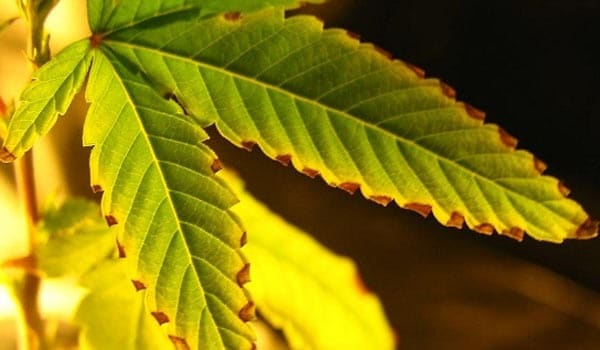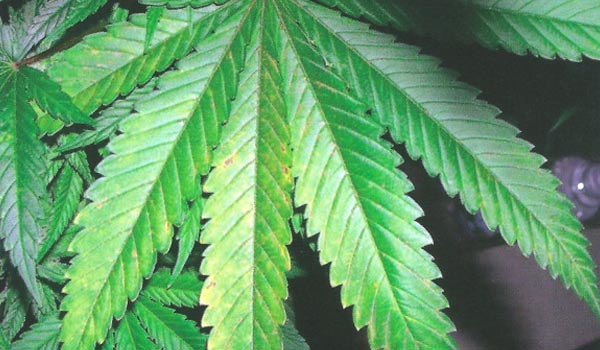
Calcium helps your marijuana plant have healthy and strong cell walls, stems, branches, and stalks. It also helps out with root hair growth and root system development.
Without enough calcium, your plant won’t be able to absorb potassium properly, either. Calcium also helps your plants handle stress factors, such as very warm temperatures.
If your plant has a calcium deficiency, these process will not be able to function properly, and it could lead to more serious problems if left unchecked. Make sure to take care of it as soon as you notice some calcium deficiency symptoms.
Signs of a calcium deficiency

If you’re growing marijuana plants outdoors, it’s unlikely for them to become deficient in calcium. The likelihood of it happening increases if your plants are growing in very acidic soil, which is often the case in pinewoods.
Sometimes plants growing in planting mixes will experience a lack of calcium, but most of all it happens to marijuana that is growing in a hydroponic system. Unless your hydroponic system has had lime, a huge source of calcium, added to it, then a calcium deficiency is not uncommon.
It also is more likely to occur with some sources of water rather than others. Distilled water, reverse osmosis water, and tap water often don’t contain much dissolved calcium – they need to be supplemented in order to provide your plants with enough calcium from the beginning.
Certain strains of marijuana have higher chances of experiencing a calcium deficiency than other strains. Some strains– sometimes even some specific plants within one strain – have more calcium than the plants next to them. This means it is not uncommon for one plant to exhibit signs of a calcium deficiency while the rest of your plants are happy and thriving.
Also LED lights offer a smaller spectrum of light. Certain wavelengths the plant requires to generate calcium are absent. So keep an eye on calcium deficiency when growing with LED.
Calcium is a semi-mobile nutrient, so the signs of a calcium deficiency begin with the new growths on your plant, but they will start moving after a period of time. You will first see it in the new growths towards to top of your plant as well as the middle vegetative growth. This is simply because it appears first in the area that is growing the fastest.
If you test out the pH of the plant’s soil and see that the pH level is too low, then adding calcium to it will not be a bad idea. Not sure if your plants have a calcium deficiency? Read the article Nutrient deficiencies in marijuana plants for a list with pictures of all deficiencies.
How to fix a deficiency in soil

The best way to fight it is to avoid it in the first place. The best way of doing that, like with other nutrient deficiencies, is to use Marijuana Booster to ensure your plants are fed with the right nutrients at the right times.
If you weren’t able to avoid it and you have found yourself dealing with a calcium deficiency, there are options. Some possible products you can use are dolomitic lime or garden lime (located in potting soil and planting mixes). They will help stabilize the pH levels of your system as well as providing your plants with calcium.
One other option is using a calcium-magnesium formula, calcium acetate, or calcium magnesium acetate to quickly relieve a calcium deficiency. PH levels of your soil should be between 6.2 and 7.0. Read the article How to measure the pH of your soil to learn how. If it isn’t around 6, flush out your system with fresh water that has the proper pH level as well as a boost of nutrients to restore the balance.
There is another compound that can help quickly with a calcium deficiency: calcium nitrate, or CaNO3 (wiki). It dissolves easily in water and is therefore easily absorbed by roots. Just be careful: don’t use calcium nitrate while your plants are in their flowering stage because it will make them have too much nitrogen.
Other products to consider are liquid calcium and liquid lime, which roots can also take in very fast. One teaspoon of hydrated lime per gallon of water is perfect for fast-acting uptake of calcium. Another option is to mix in dolomitic limestone with your planting mix. This will help over a greater amount of time, rather than just being a quick fix. These products can be bought at this online grow shop
How to fix a deficiency in hydro

Fixing a calcium deficiency is a crucial piece of knowledge for any hydroponicgrower, since they happen much more commonly in this case. Since water naturally contains a certain amount of calcium, hydro fertilizers often don’t contain very much calcium.
As long as your water has more than 150 ppm of dissolved solids, then calcium deficiency should not be a problem for you. If it has less than 150 ppm, then it’s probably a good idea to add some calcium and magnesium to make sure your plants will receive enough of these nutrients to thrive.
The pH level also comes into play with a calcium deficiency in a hydro setup. If the pH level is outside the range of 6.2 to 6.5, you are more likely to have a calcium deficiency than if it is within this range. Flush out your system with fresh water that has the proper pH level as well as a boost of nutrients to restore the balance.
Calcium and lime in their liquid forms work well for fast absorption into the roots. Try using one teaspoon of hydrated lime per gallon of water and feed that to your plants. You will quickly see the results.
Although feeding too much calcium marijuana plants in any system is unlikely, make sure you don’t feed them so much they lock out the other nutrients. Otherwise, you will end up dealing with another nutrient deficiency straight away! Get your nutrients at my favorite online grow shop
How to fix a deficiency outdoors

If you’re growing your plants outdoors and you’re working with soil that is acidic, try infusing calcium into that acidic soil. This will help the soil become a more ideal pH level – between 6.0 and 6.5. You can use dolomitic lime, garden lime, fish bones, seashell, or ground up egg shells to accomplish this and make sure your soil has plenty of calcium for a longer period of time.
Another option for outdoor growers is using gypsum or calcium sulfate (wiki). Be aware of your soil’s current pH level before you do this, however. If it is below 5.5, don’t add gypsum at all because it then interacts with aluminum (Al) and will poison your plants! Gypsum is a good option for people who have tested their outdoor soil and see that it is within the ideal range since gypsum doesn’t mess with the pH level very much.
Read the article How to measure the pH of your soil to test the ph levels of your outdoor soil.
List of marijuana plant symptoms
Leaf Color:
– Leaves’ green color darkening
– Large, light brown necrotic spots
Leaf Symptoms:
– Spotting and mottling
– New leaves are small and distorted
– The tips of leaves curl
– Leaves are dying off
Plant Symptoms:
– Flower or bud development is slow or buds never fully develop
– Stunted growth
– Young shoots are crinkling
– Young shoots are discolored – purple or yellow
– Stems and branches are weak, easily broken
– Stems are hollowing out or decaying from the inside
– Plant doesn’t withstand heat well
Root Symptoms:
– Roots may begin dying off or turning brown
– Root systems not fully developed
– Root diseases and bacterial diseases
– Roots more vulnerable to slimy root rot
Remember that plants with strong genetics have less change of getting sick. Make sure you buy marijuana seeds from a trusted seedbank.
Calcium deficiencies can sometimes be tricky to spot because they often come with other deficiencies – especially in magnesium and iron. Because of this, lots of growers will buy a calcium-magnesium (“Cal-Mag”) supplement to have on hand, in case they see signs of a calcium deficiency within their grow room.
0 Comment:
Post a Comment